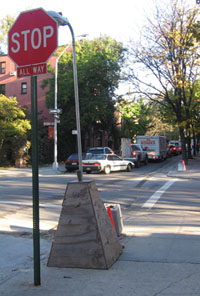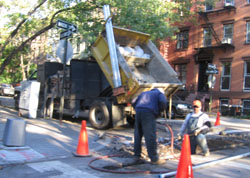Reverse Engineering Pedestrian Safety in Boerum Hill
 They are putting up a traffic light on my corner this week. It’s one of the last intersections in Boerum Hill with four-way stop signs, at Bond and Wyckoff Streets, and I can’t imagine who thought this was a good idea.
They are putting up a traffic light on my corner this week. It’s one of the last intersections in Boerum Hill with four-way stop signs, at Bond and Wyckoff Streets, and I can’t imagine who thought this was a good idea.
It would seem obvious that stop signs are much preferable to a traffic light in this type of a neighborhood setting, especially where two residential streets meet. Anyone who drives in New York City, as I do all too often, knows that most motorists speed up when as they approach a green light to make it through the intersection and hopefully catch the next light at the other end of the block.
This means that a large percentage of traffic moving down my block will now be going significantly faster than it did before, because with the stop sign, every car used to stop, or slow to a near stop, before proceeding. People already use my street as a cut-through from Cobble Hill to Park Slope, and this will only make matters worse.
It is true that a stop sign is not heeded in the same way a red light is, but as someone who walks through that intersection almost every day, frequently with small children in tow, I cannot remember a time when I had any trouble at all crossing safely.
 In fact, it is easier in a lot of ways to work out the dynamic with an approaching or waiting car when at a stop-controlled intersection. At a stop sign, most drivers are looking for pedestrians and other cars because there is no traffic light telling them they have "the green light" to blast through the intersection. The same thing was true for me as a pedestrian. Approaching the curb, I frequently made eye contact with drivers, who would often wave me across the street. The stop signs forced drivers and walkers to interact in a human relationship, however cursory. With a traffic signal, the intersection is governed from the top down and there is no longer any need for human interaction. One of the results is that the intersection is a whole lot less safe.
In fact, it is easier in a lot of ways to work out the dynamic with an approaching or waiting car when at a stop-controlled intersection. At a stop sign, most drivers are looking for pedestrians and other cars because there is no traffic light telling them they have "the green light" to blast through the intersection. The same thing was true for me as a pedestrian. Approaching the curb, I frequently made eye contact with drivers, who would often wave me across the street. The stop signs forced drivers and walkers to interact in a human relationship, however cursory. With a traffic signal, the intersection is governed from the top down and there is no longer any need for human interaction. One of the results is that the intersection is a whole lot less safe.
What I’d like to know is: What city agency or official made this change and why? If one car in ten thousand is speeding through the stop sign at 2:00 a.m., will a red light make any difference to that scofflaw? If pedestrian safety is the concern, there are many other tools the city could use to make the intersection safer, including street narrowing, regularly re-striping the crosswalk or building curb extensions to shorten crossing distances. These options are no more expensive or difficult than installing and maintaining a new traffic signal. Lastly, why isn’t such a decision the topic of at least a conversation with the community where the pros and cons of such things can be weighed out?